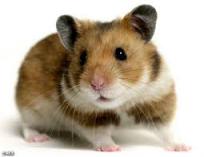
Looking After Your Hamster
The most common pet hamster is the six-inch Syrian and have a lifespan of two to three years. Dwarf species such as the Siberian, Roborovsky’s Djungarian, and Chinese are smaller than Syrians, at about two to three inches. They have an average lifespan of one to two years.
Although they’ve been viewed as the quintessential pet for children, hamsters are nocturnal by nature—which does not fit well into a young child’s schedule. If you are up in the wee small hours or won’t be bothered by your pet’s nightly digging, scratching and wheel-running, a hamster may fit in nicely in your home.
Hamsters also have gained a reputation for biting, but they mostly tend to nip when awakened during the day—the time they are “biologically programmed” to sleep. Children under the age of six should not be allowed to handle these fragile animals, and those over six should always be supervised by an adult.
Housing
When selecting a cage, keep in mind the golden rules of happy hamster housing. Syrian hamsters are solitary and MUST live alone. One Syrian hamster per cage—no exceptions! Dwarf hamsters are social, on the other hand, and like to live in pairs. Do not house male and female dwarf hamsters together, since rodents breed quickly—and often—with large litters.
Keep your Syrian hamster in a wire cage or a ten-gallon aquarium with a wire-mesh top. The fancier cages with tubes, tunnels and hideaways are good, too, but they generally cost more and are harder to clean. If you have space for a larger cage, it will be much appreciated. Dwarf hamsters can be kept in a cage made for mice.
The enclosure should be placed away from direct sunlight and drafts, and lined with an absorbent bedding such as timothy hay, aspen shavings, shredded paper or pelleted bedding. Do not use pine or cedar chips, as the fumes from these products can be harmful to your pets.
Hamsters are big on exercise, so please make sure yours has a wheel for running. Hamsters also like to hide and sleep inside enclosed spaces, so you’ll need a small box with an entrance hole or a small flower pot for this purpose. And they love crawling through tubes, which can be homemade (empty cardboard tubes from paper towels and toilet paper!) or purchased from a pet supply store. And finally, you may notice that your hamster is a major creature of comfort. Remember to regularly give him small pieces of paper towel or napkin to shred and make a nest with.
Diet
Your pet will do well on hamster mix, which contains seeds, grains, cracked corn and pellets, and is readily available in our store.
We recommend that you supplement your pet’s diet with fresh foods every two or three days. Try fresh grains, sunflower seeds and nuts (not too many, please, as these are high in fat), alfalfa pellets, and fresh fruits and vegetables such as spinach, lettuce, carrots and apples. Be sure to clean up any leftover fresh food before it spoils. Never give your pet raw kidney beans, onions, raw potato, rhubarb, chocolate, candy or junk food.
Fresh, clean water should be available at all times. It is best to use an inverted bottle with a drinking tube, which should be changed daily.
Your hamster will stuff his face (literally!) and then empty out whatever’s in his pouch for some late-night snacking. That’s why it’s important to check the corners of the cage for any hidden stashes when cleaning.
General Care
Don’t forget your housekeeping duties! Remove droppings, uneaten food and soiled bedding every day. Every week, remove and replace all the bedding, and scrub the bottom of the cage with hot, soapy water.
A hamster’s teeth grow continuously, so your pet will need to chew—a lot—to keep his choppers in tip-top condition. Make sure he always has a piece of wood or twig that has not been treated with pesticides, other chemicals or paints. Pieces of dog biscuit will work well, too.
It’s important to get yourhamster used to you, and used to being handled. Start by feeding your hamster treats; once he’s comfortable accepting treats from your hand, you can gently and securely pick him up. Hold him for a short time at first, and then gradually increase your time with him.
Once you’ve hand-tamed your hamster, every day you should let him play outside of the cage, in a secure, enclosed area, while you supervise. Be sure to remove any electrical wires from the area, and anything else your curious pet could, but shouldn’t, gnaw on.
Health
If you think your pet is sick, don’t delay—seek medical attention immediately. Common signs that something isn’t right with your hamster may include:
- dull-looking eyes
- matted fur
- weight loss
- shaking
- runny nose
- diarrhea.
Also note that hamsters seem to be susceptible to respiratory problems, especially the common cold, which they can catch from their human pet parents.

